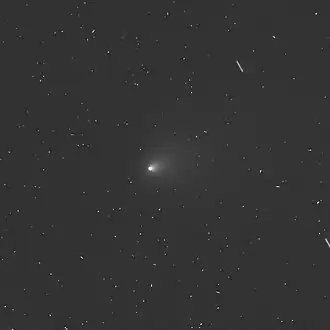47P/Ashbrook–Jackson
 Comet Ashbrook–Jackson photographed by the Hubble Space Telescope on 26 July 2000 | |
| Discovery | |
|---|---|
| Discovered by | Joseph Ashbrook Cyril V. Jackson |
| Discovery site | Lowell Observatory, USA South Africa |
| Discovery date | August 26, 1948 |
| Designations | |
| P/1948 Q1, P/1955 H1[1] | |
| |
| Orbital characteristics[2][3] | |
| Epoch | 5 May 2025 (JD 2460800.5) |
| Observation arc | 76.93 years |
| Number of observations | 3,274 |
| Aphelion | 5.428 AU |
| Perihelion | 2.807 AU |
| Semi-major axis | 4.118 AU |
| Eccentricity | 0.31822 |
| Orbital period | 8.356 years |
| Inclination | 13.038° |
| 356.88° | |
| Argument of periapsis | 357.91° |
| Mean anomaly | 339.25° |
| Last perihelion | 10 June 2017 |
| Next perihelion | 28 October 2025 |
| TJupiter | 2.907 |
| Earth MOID | 1.811 AU |
| Jupiter MOID | 0.016 AU |
| Physical characteristics[4][5] | |
Mean diameter | 5.6 km (3.5 mi) |
| 15.6 hours[a] | |
| Comet total magnitude (M1) | 13.5 |
47P/Ashbrook–Jackson is a periodic comet in the Solar System.
The comet nucleus is estimated to be 5.6 kilometers in diameter.[2]
History
Comet 47P/Ashbrook–Jackson was discovered by Joseph Ashbrook and Cyril Jackson in 1948.
Name
47p is in the name because it was the 47th periodic comet discovered. Ashbrook–Jackson is the names of its two discoverers.
Apparitions
- October 28, 2025
- June 10, 2017
- January 31, 2009
- January 6, 2001
- July 14, 1993
- January 24, 1986
- August 19, 1978
- March 13, 1971
- October 2, 1963
- April 6, 1956
- October 4, 1948
References
Notes
Citations
- ^ "Comet Names and Designations". International Comet Quarterly. Retrieved 7 August 2025.
- ^ a b "47P/Ashbrook-Jackson – JPL Small-Body Database Lookup". ssd.jpl.nasa.gov. Jet Propulsion Laboratory. Retrieved 1 March 2010.
- ^ "47P/Ashbrook–Jackson Orbit". Minor Planet Center. Retrieved 2 March 2017.
- ^ a b R. Kokotanekova; C. Snodgrass; P. Lacerda; S. F. Green; S. C. Lowry; et al. (2017). "Rotation of cometary nuclei: new light curves and an update of the ensemble properties of Jupiter-family comets". Monthly Notices of the Royal Astronomical Society. 471 (3): 2974–3007. arXiv:1707.02133. Bibcode:2017MNRAS.471.2974K. doi:10.1093/mnras/stx1716.
- ^ P. L. Lamy; I. Toth; Y. R. Fernández; H. A. Weaver (2004). "The Sizes, Shapes, Albedos, and Colors of Cometary Nuclei" (PDF). Comets II. pp. 223–264. JSTOR j.ctv1v7zdq5.22.
External links
- 47P/Ashbrook–Jackson at the JPL Small-Body Database
- 47P/Ashbrook–Jackson at Seiichi Yoshida's website
- 47P/Ashbrook–Jackson at Gary W. Kronk's Cometography

.png)